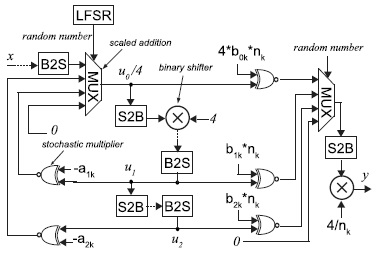- ALL COMPUTER, ELECTRONICS AND MECHANICAL COURSES AVAILABLE…. PROJECT GUIDANCE SINCE 2004. FOR FURTHER DETAILS CALL 9443117328


Projects > ELECTRONICS > 2017 > IEEE > VLSI
This paper introduces area/energy-efficient gammatone filters based on stochastic computation. The gammatone filter well expresses the performance of human auditory peripheral mechanism and has a potential of improving advanced speech communications systems, especially hearing assisting devices and noise robust speech-recognition systems. Using stochastic computation, a power-and-area hungry multiplier used in a digital filter is replaced by a simple logic gate, leading to area efficient hardware. However, a straightforward implementation of the stochastic gammatone filter suffers from significantly low accuracy in computation, which results in a low dynamic range (a ratio of the maximum to minimum magnitude) due to a small value of a filter gain. To improve the computation accuracy, gain-balancing techniques are presented that represent the original gain as the product of multiple larger gains introduced at the second-order sections. In addition, dynamic scaling techniques are proposed that scales up small values only on stochastic domain in order to reduce the number of stochastic bits required while maintaining the computation accuracy.
Stochastic/Binary Hybrid Computation, Stochastic Arithmetic Method.
In this paper, we introduce an area/energy-efficient gammatone filter based on stochastic computation. In general, stochastic computation designed using digital circuits represents data as streams of random bits, while a power-and area hungry multiplier used in a digital IIR filter is replaced by a simple logic gate, leading to area-efficient hardware. The area efficiency is exploited for the hardware implementation of a stochastic gammatone filter. First, a stochastic gammatone filter is designed using a straightforward implementation technique and is then analyzed in terms of a dynamic range. The dynamic range is used as a ratio of the maximum to minimum magnitude throughout this paper. Based on the analysis, the straightforward implementation suffers from significantly low computation accuracy due to a small value of a filter gain, which results in a low dynamic range. To improve the computation accuracy, gain-balancing techniques are presented. In the gain-balancing techniques, the original gain is represented by the product of multiple larger gains introduced at the second-order sections, avoiding the small value of the filter gain represented using stochastic bit streams. In addition, dynamic scaling techniques are proposed in order to avoid using small values of signals represented by stochastic bit streams. These techniques dynamically scale up small values only on stochastic domain, reducing the number of stochastic bits required while maintaining the computation accuracy.
Overall structure using normalized coefficients
